BLM to Analyze Potential Changes to West-wide Energy Corridors as Part of President Biden’s Investing in America Agenda
Organization:
Media Contact:
WASHINGTON – Today, the Bureau of Land Management announced that it will begin assessing targeted updates to energy corridors across the West, to help speed deployment of transmission infrastructure. The analysis will examine potential changes to the designations that could strengthen energy security, promote renewable energy development in the West, improve reliability, relieve congestion, and enhance the capability of the national grid to deliver electricity. Approximately 673 miles of seven designated energy corridors may potentially be modified.
"Transmission is a vital piece of moving our country to a clean energy economy,” said BLM Director Tracy Stone-Manning. “These updates will help plot a course for successful transmission deployment in order to bring renewable energy to markets across the West.”
The BLM will use a $1.2 million investment from President Biden’s Inflation Reduction Act to support this effort. This work is central to the Investing in America agenda and supports broader Biden-Harris Administration efforts on efficient siting and permitting of transmission lines.
These corridors, known as West-wide energy or Section 368 corridors, stretch across Western states and help guide responsible buildout of transmission lines and other uses to balance the need for delivering clean energy with protecting America’s lands, water, and wildlife habitat.
Making revisions to these corridors, originally designated in 2009, requires interstate coordination and national-level planning to be implemented efficiently and effectively. BLM began internal planning for this effort using BLM’s Regional Review Final Report. The seven prioritized, specific energy corridors will affect 19 resource management plans across Arizona, California, Colorado, Nevada, New Mexico, Utah, and Wyoming.
In January 2009, the BLM and the Forest Service issued land-use planning decisions designating approximately 6,000 miles of West-wide energy corridors, consistent with the direction in Section 368 of the Energy Policy Act of 2005. These designations are intended to serve as preferred locations on Federally managed lands for the siting of electric transmission and distribution lines and pipelines, including hydrogen pipelines.
As part of a settlement to resolve a lawsuit challenging the corridor designation decisions, the BLM and Forest Service agreed to review and consider recommendations for revisions, deletions, and additions of the corridors. The BLM’s current planning effort will evaluate the recommendations to modify some of the designated West-wide corridors, in part to ensure avoidance of significant known resource and environmental conflicts. The project’s total cost is $1.9 million.
The BLM will hold four in-person and two virtual public scoping meetings to collect comments and local input. (Locations and times follow, and all times are Mountain Standard):
In-Person Meetings:
- January 9, 2024 – Cedar City, UT: Cedar City Heritage Center, 96 N. Main St. (4 p.m. to 7 p.m.)
- January 10, 2024 – Laughlin, NV: Laughlin Regional Government Center, 101 Civic Way (4 p.m. to 7 p.m.)
- January 11, 2024 – Phoenix, AZ: BLM National Training Center, 9828 N. 31st Avenue (4 p.m. to 7 p.m.)
- January 17, 2024 – Craig, CO BLM Little Snake Field Office, 455 Emerson Street (4 p.m. to 7 p.m.)
Virtual Meetings: Visit EplanningUi (blm.gov) to register
- January 9, 2024 (10 a.m. to 11 a.m.)
- January 18, 2024 (10 a.m. to 11 a.m.)
For more information, please visit the Section 368 Energy Corridors Regional Review Revisions ePlanning website https://eplanning.blm.gov/eplanning-ui/project/2022227/510 at the West-wide Energy Corridor Information Center website at http://corridoreis.anl.gov, or contact Crystal Hoyt, BLM National Project Lead, at [email protected] or 307-352-0322.
The BLM manages about 245 million acres of public land located primarily in 12 western states, including Alaska, on behalf of the American people. The BLM also administers 700 million acres of sub-surface mineral estate throughout the nation. Our mission is to sustain the health, diversity, and productivity of America’s public lands for the use and enjoyment of present and future generations.

